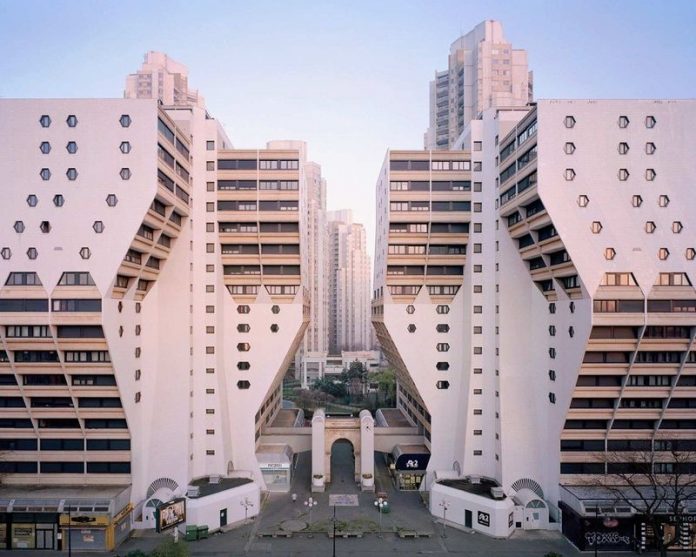The academic textbooks from the turn of the century also confirm the isolation of academic circles. Professor Julien Guadet emphasizes the importance of composition in his monumental book Éléments et théorie de l’architecture in which he describes how to match the separated elements of a building to a regularly established plan.
Guadet writes To compose is to make use of what is known (ce qu’on sait). Composition has materials, just as construction has, and these materials are, precisely, the Elements of Architecture. (…) Nothing, to be sure, is more engaging than composition, nothing more seductive. It is the true realm of the artist with no limits or frontiers, but the impossible. What is it to compose? It is to put together, weld, unite the parts of a whole.
These parts, in their turn, are the Elements of Composition, and just as you will realise your conceptions with walls, openings, vaults, roofs – all elements of architecture – you will establish your composition with rooms, vestibules, exits and staircases. They are the Elements of Composition.
The author then explains the process of composing, which is in stages: small structural and functional elements (architecture components) are combined into larger functional spatial units (composition elements) that comprise the entire structure. Relegating composition as a parent task of the architect did not in any way ignore the matter of progress in the field of construction. Conversely, Julien Guadet emphasizes his powers and progressivism, using the titles of professor and construction engineer by his name on the title page of the said work.
The composition of the elements of architecture has become weapon in the competitive activity of “ordinary” building engineers with a higher rank of artistry and humanistic values – secret knowledge available only to narrow elites of acquainted architects. As the author of the academic textbook, Julien Gaudet presents himself as a cosmopolite. He presents examples of architecture from different countries, eras, and cultural circles, including Arabic Islam, treating all equally and looking for beauty and patterns for modern mimetic creation.
He does not emphasize the problem of symmetry as he discusses the architecture of various types of objects, both monumental and residential in various aspects – from utilitarian and formal to decorative. Although within the two architectural formations – classicism and modernism – there were different design methods and the classical harmony of the symmetrical plan put form above the utility requirements, the Gaudet principle proposes that each function corresponding to a specific, separate spatial unit, clearly marked in the block of the building, became a feature of the progressive architecture of the early 20th century.
For example, Walter Gropius followed the principle of elementary composition as part of his teaching in the Bauhaus school and in his design of the new Bauhaus school building in Dessau (1926). On the way towards modernity, academicism played two roles. On the one hand, it applied a brake on progress in architecture. It appeared that it was easier to adapt new materials and technologies to existing aesthetic standards and styles than create new forms and spatial patterns adequate for the industrial age and the machine era.
Cast iron was the only new instrument, as it enabled the design of eclectic and pretentious façades, to satisfy the unfussy bourgeoisie or pseudo-monumental edifices reminiscent of the imperial past. This new tool, through its use, has brought naturally restored forms to the functions of false façades. On the other hand, academicism held traditional values that avant-garde modernists, educated in classical tradition, tried to adapt to new materials, forms, and goals. The feeling of change already appeared in the mid-19th century when the accelerated progress of industry signalled ever more clearly to the architects that their privileged position was threatened and their means of expression old- fashioned.
In the architectural writings of the time, there was a series of statements announcing the coming breakthrough. The new architecture that brings us out of the barren past and the servile of copying is what we all demand and what the people are waiting for. (…) Mankind will create a completely new architecture derived from its time precisely at that moment in which new methods created by the industry are used. The use of cast iron allows and contributes to the wider use of many new forms; this is evident in the railway stations, the hanging bridges and the orangeries’ arches.
One of the initiators of the renewal of architecture was Henri Labroust, a graduate of the L’École Royale des Beaux-Arts. He opposed the teaching methods used there and so in 1830 founded his own studio and architectural school, which provided an education based on rational principles. Ahead of the assumptions of functionalism, Labroust shared with his brother some thoughts on teaching in a letter. I often repeat to them (students) that art has the power to make everything beautiful but I insist that in architecture the form must always match the function it is intended for.
However, on the threshold of the 20th century, neither Europe nor America was ready to develop the doctrine of modernism, which was based on two fundamental principles – a departure from historical styles and, consequently, acceptance of fitness for purpose as a criterion of value.18 Only the collapse of the economic and social systems, as a consequence of the outbreak of World War I and the Russian Revolution, gave the impetus needed to take on its challenges to continue engineering development and construction techniques which started 150 years ago.
